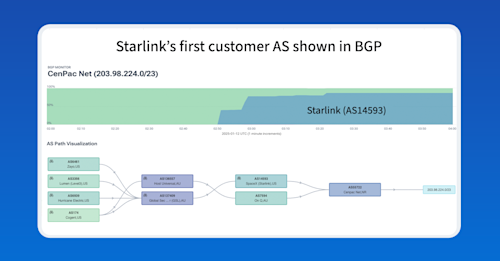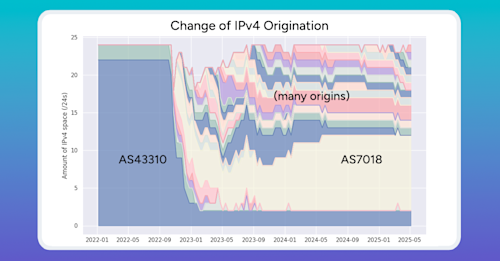Blast-Off: Three Years of Starlink's Growth, as Told in GeoIP Data - Part 1


Summary
Starlink, the revolutionary low-earth-orbit satellite-based internet service, has quickly become one of the most transformative technologies in the world of internet communications. Using over three years of GeoIP data, we analyze the growth of Starlink as it expanded from 41 to 157 countries. This evolution included the emergence of “Community Gateways” and notable GeoIP entries for locations like Mars, Antarctica, SpaceX launch sites, and politically sensitive areas such as the Palestinian Territories, Kosovo, Venezuela, Myanmar, and Sudan.
In the initial months following Russia’s invasion into Ukraine in 2022, internet service, like the rest of the country, was under attack. As parts of the country descended into war zones, communication disruptions became regular events, caused by everything from cyber attacks to power outages and fiber cuts.
As the world rallied to Ukraine’s defense, Elon Musk pledged the support of Starlink, his revolutionary low-earth-orbit satellite-based internet service. Ever since that first batch of Starlink antennae arrived in Kyiv that March (pictured below), Starlink has played a vital role in keeping Ukraine (especially its military) connected to the internet.

Soon after the arrival of Starlink service in Ukraine, we began downloading Starlink’s GeoIP file every two hours. In April 2025, we passed three years of snapshots of these files — likely the largest collection of Starlink GeoIP data outside of Starlink itself.
What is the Starlink GeoIP file?
A GeoIP file is simply a CSV file containing the self-reported geolocations of the IP ranges originated by a network, as defined by RFC 8805. Each line is an entry which contains four fields: IP prefix range, two-letter country code, region code, and a city label.
This is an example line:
129.222.112.0/24,CA,CA-MB,Winnipeg,Which can be interpreted as:
Prefix: 129.222.112.0/24
Country: CA
Region: CA-MB
City: Winnipeg
However, there is no assurance of accuracy and no guarantee that the listed IP ranges are in use or even routed.
When Starlink user terminals (aka Dishy McFlatface antennae) connect to the internet, they are assigned an IP address (or residential users a CGNAT-Gateway bearing such) that corresponds to their location in the GeoIP file. This ensures that Starlink users are provided appropriate access to geofenced online media as well as receiving the appropriate language localization to international websites, like www.google.com.
Starlink users communicate with the internet by either having their signal relayed back to a ground station within the footprint of the satellite(s) they are connecting to, like traditional bent-pipe satellite internet, or use optical inter-satellite laser links (OISL) to hop from one satellite to another, traversing space until coming down at a faraway ground station. Starlink is the first large-scale satellite operator to employ OISLs.
Lastly, these entries can also be placeholders for future locations. For example, at the time of this writing, Starlink has not yet been authorized for use in India, and yet there have been entries for Mumbai in the GeoIP file for the entire duration of the period of analysis.
2406:2d40:a000::/40,IN,IN-MH,Mumbai,Having said all that, the contents of Starlink’s GeoIP file tell the story of this singular internet modality’s evolution over time. Now, more than three years after beginning to record this data, it’s time for it to tell us its stories.
Planetary expansion
In the time we’ve been downloading it, Starlink’s GeoIP file grew from 1,535 to 2,473 lines long (currently 2,074 entries for IPv4 and 519 for IPv6). In that time, the number of unique countries contained in it grew from 41 to 157.
The graphic below shows the growth of the GeoIP file from April 2022 to July 2025 by tracking the amount of unique IP space for IPv4 and the number of entries for IPv6, since the ranges can be extremely large in size. In either case, most of the growth has occurred outside of the United States (blue).
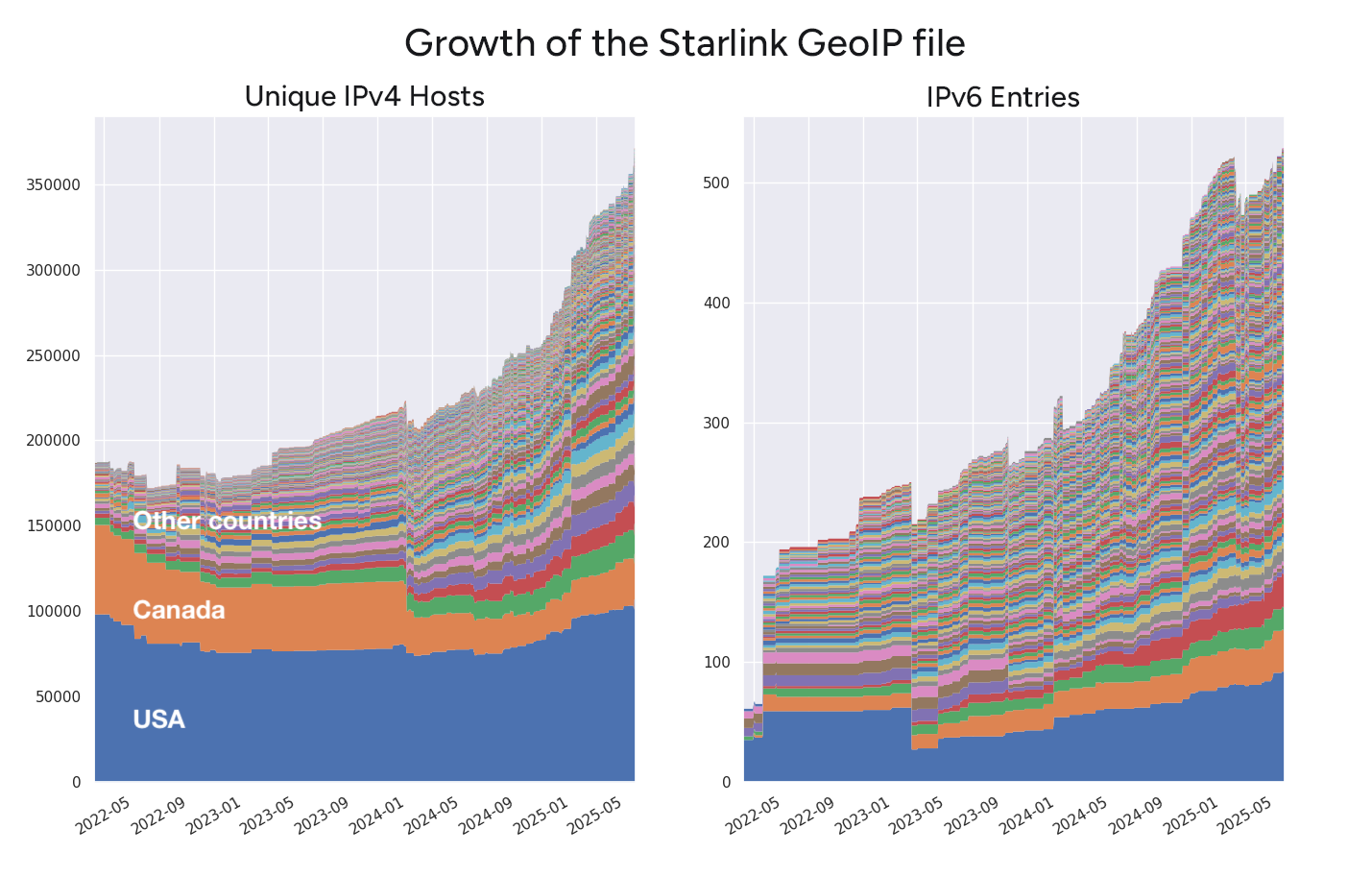
The size of the IP ranges has evolved over the years as well. For IPv4, the most popular size of the IPv4 entry was once a /27, representing 32 unique IP addresses. Now the most popular size is /24 (256 addresses), followed by /25. A /23 appeared for just one day in March 2024 when 129.222.98.0/23 was temporarily assigned to Nairobi, Kenya.
| IPv4 prefix sizes | April 2022 | July 2025 |
| /24 | 592 | 1090 |
| /25 | 56 | 567 |
| /26 | 60 | 199 |
| /27 | 766 | 212 |
| /28 | 0 | 6 |
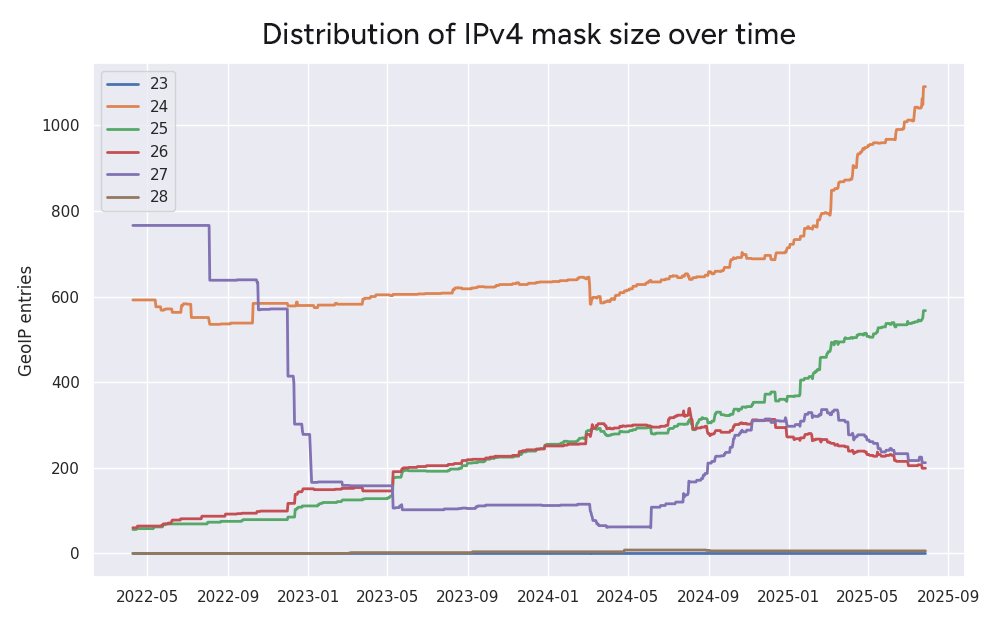
Represented in the table below, the evolution of the distribution of IPv6 prefix sizes is more profound. This likely relates to the service’s expansion of IPv6-based internet services over this period of time. Back in April 2022, the 61 IPv6 entries were all one size: /36 (representing 2^92 or a mere 4.95 sextillion unique addresses). Now there are hundreds of IPv6 entries with /42’s and /40’s being the most popular.
| IPv6 prefix sizes | April 2022 | July 2025 |
| /36 | 61 | 0 |
| /38 | 0 | 0 |
| /40 | 0 | 249 |
| /41 | 0 | 25 |
| /42 | 0 | 219 |
| /45 | 0 | 1 |
| /46 | 0 | 1 |
| /47 | 0 | 2 |
| /48 | 0 | 28 |
| /49 | 0 | 1 |
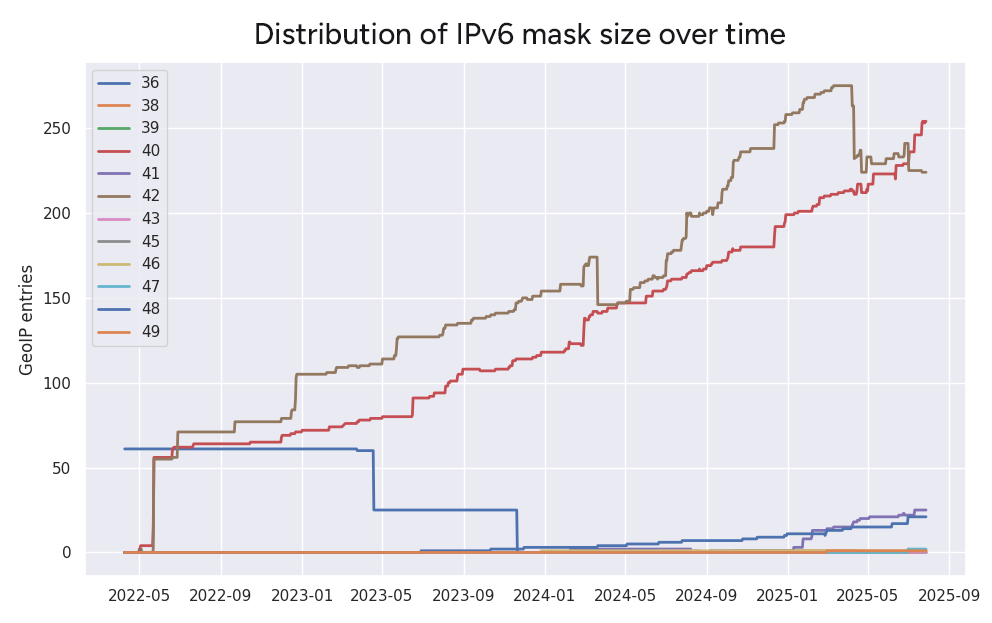
Since we record changes every two hours, we also observe patterns of when the file changes the most during the course of a day. The graphic below depicts the number of line changes by time of day in the past 3.25 years — most changes take place between 20:00 and 04:00 UTC.
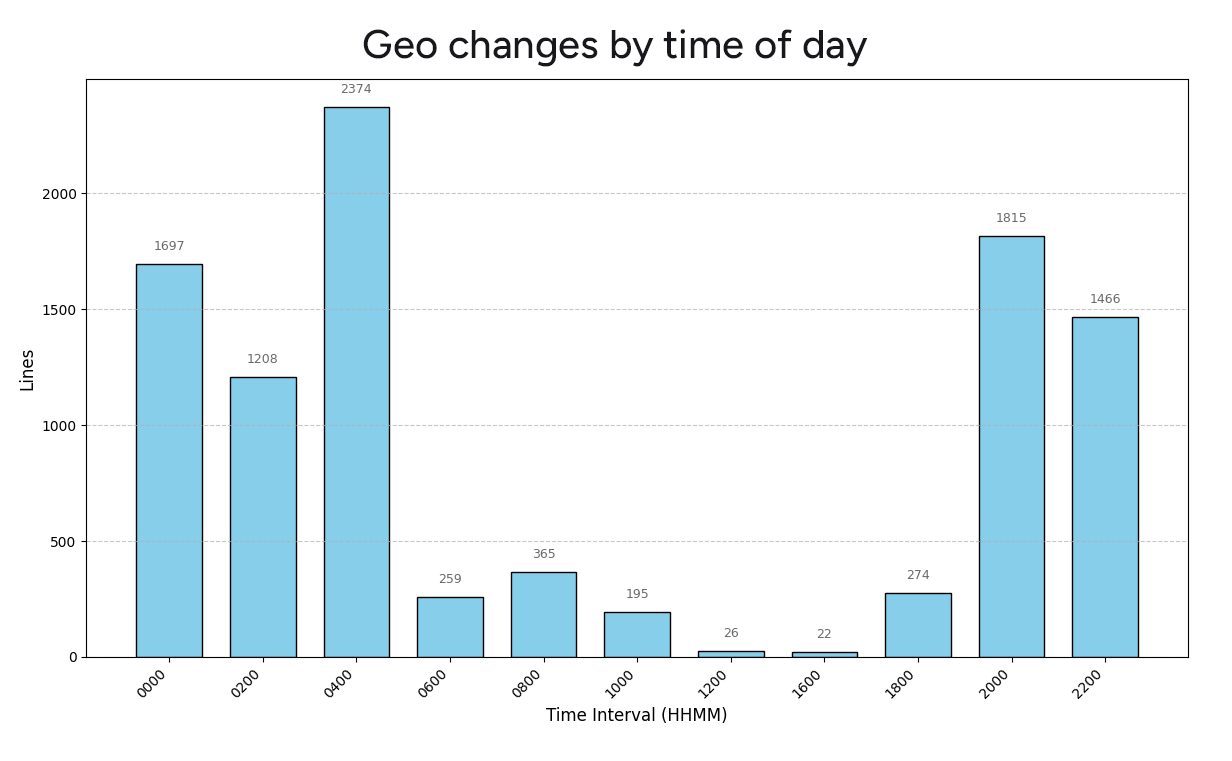
When we plot these changes by time-of-day over time, we arrive at the following visualization that reveals both a general lack of activity between 06:00 and 18:00 UTC and an uptick of activity from the end of February 2024.
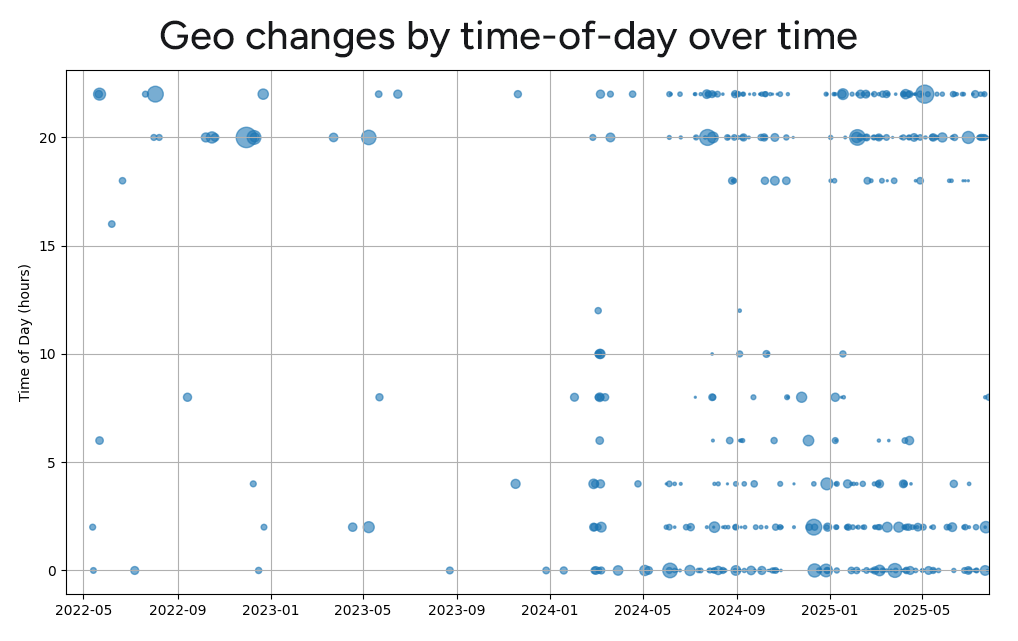
Notable GeoIP Entries
With the high-level analysis out of the way, let’s dive into a few notable highlights we observed in this data set — beginning with the interstellar.
Mars
November 30, 2022 — briefly
As mentioned above, near the end of November 2022, Starlink suffered a platform-wide outage. While the outage only lasted under two hours, the restoration of service coincided with the publication of a very different GeoIP file containing numerous new entries.

The most eyebrow-raising addition to the file was a new entry for the planet Mars:
98.97.73.224/27,XX,XX-XY,Mars,Sending a human to the red planet has long been a dream of Elon Musk. And to communicate with our future Martian colony, he has proposed creating a satellite-based relay network called Marslink.
Only time will tell if Marslink ends up using one of these IP addresses. The Mars entry was removed when a revised GeoIP was published a couple of hours later.
Israel and the Palestinian Territories
First appeared October 19, 2023 and November 28, 2023
As Israel launched its military campaign into the Gaza Strip in response to the October 7 attacks by Hamas, much of Gaza’s infrastructure was disrupted by the war. On November 29, Starlink announced that it had come to an agreement to offer satellite internet service to Gaza under the supervision of the Israeli government. Service would become available in Israel as well.
But before all of that happened, the first entries appeared in Starlink’s GeoIP file for Israel at the beginning of the day on October 19, 2023.
216.128.14.0/24,IL,IL-JM,Jerusalem,
216.128.15.0/24,IL,IL-JM,Jerusalem,
2a0d:3344:17c0::/42,IL,IL-JM,Jerusalem,Early on November 29, 2023, presumably following the agreement with Israel, five new entries appeared labeled as being located in Ramallah in the Palestinian West Bank.
216.128.20.0/25,PS,PS-RBH,Ramallah,
216.128.20.128/25,PS,PS-RBH,Ramallah,
216.128.21.0/26,PS,PS-RBH,Ramallah,
216.128.21.64/26,PS,PS-RBH,Ramallah,
2a0d:3341:b040::/42,PS,PS-RBH,Ramallah,These days, the Palestinian Territories are represented by three entries (two IPv4 and one IPv6) after 216.128.21.128/25 was reassigned from Amsterdam to Ramallah on January 21, 2025.
216.128.20.0/24,PS,PS-RBH,Ramallah,
216.128.21.0/24,PS,PS-RBH,Ramallah,
2a0d:3341:b040::/42,PS,PS-RBH,Ramallah,According to a Palestinian source in Gaza, the only Starlink connection in Gaza is the one operated by the UAE-funded field hospital in Rafah in the southern part of the strip.
Antarctica
First appeared November 30, 2022

Antarctica — perhaps the most remote location on planet earth — now has Starlink service. In fact, Starlink has a helpful page on its website explaining how to order service from this polar continent. Entries first appeared in the GeoIP file at 20:00 UTC on November 30, 2022.
103.152.127.0/25,AQ,AQ-AQ,Antarctica,
103.152.127.128/26,AQ,AQ-AQ,Antarctica,
103.152.127.192/26,AQ,AQ-AQ,Antarctica,
2406:2d40:4500::/42,AQ,AQ-AQ,Antarctica,Cape Canaveral and Starbase
First seen October 25, 2024 and December 31, 2024

Located on Florida’s Atlantic coast, Cape Canaveral hosts the Kennedy Space Center, a popular launch site for SpaceX rockets. The SpaceX Starbase is a rocket manufacturing and launch facility that serves as the main testing and production location for the ambitious aerospace company.
As such, these important locations received their own entries in the GeoIP file last year:
129.224.223.0/24,US,US-FL,Cape Canaveral,2605:59c7:f082::/48,US,US-FL,Cape Canaveral,
2605:59c7:f009::/48,US,US-TX,Starbase,Pristina, Kosovo
First appeared October 20, 2024
Kosovo declared its independence from the Republic of Serbia in 2008 and enjoys recognition from only 108 out of 193 member states of the United Nations. Kosovo’s independence is, most notably, not recognized by Serbia, which considers Kosovo to be an autonomous province of its country.
Kosovo first appeared in Starlink’s GeoIP file in October 2024 using the country code “XK.” Considered to be “user assigned” ISO 3166 code for Kosovo, XK doesn’t appear in the official standard.
212.105.144.64/26,XK,XK-XK,Pristina,
212.105.144.128/26,XK,XK-XK,Pristina,
212.105.144.0/27,XK,XK-XK,Pristina,
212.105.144.32/27,XK,XK-XK,Pristina,
212.105.144.192/27,XK,XK-XK,Pristina,
212.105.144.224/27,XK,XK-XK,Pristina,
2a0d:3344:3840::/42,XK,XK-XK,Pristina,Within a few hours, the country code was changed to be “RS” for the Republic of Serbia and the region code to RS-KM for the Autonomous Province of Kosovo and Metohija (APKM).
212.105.144.64/26,RS,RS-KM,Pristina,
212.105.144.128/26,RS,RS-KM,Pristina,
212.105.144.0/27,RS,RS-KM,Pristina,
212.105.144.32/27,RS,RS-KM,Pristina,
212.105.144.192/27,RS,RS-KM,Pristina,
212.105.144.224/27,RS,RS-KM,Pristina,
2a0d:3344:3840::/42,RS,RS-KM,Pristina,Starlink announced the activation of its service in Kosovo on December 21, 2024. Despite the usage of the Serbia-friendly “RS-KM” region code, Starlink’s Availability Map differentiates Kosovo (marked as ‘Available Now’) from Serbia (marked as ‘Starting in 2025’), shown below.
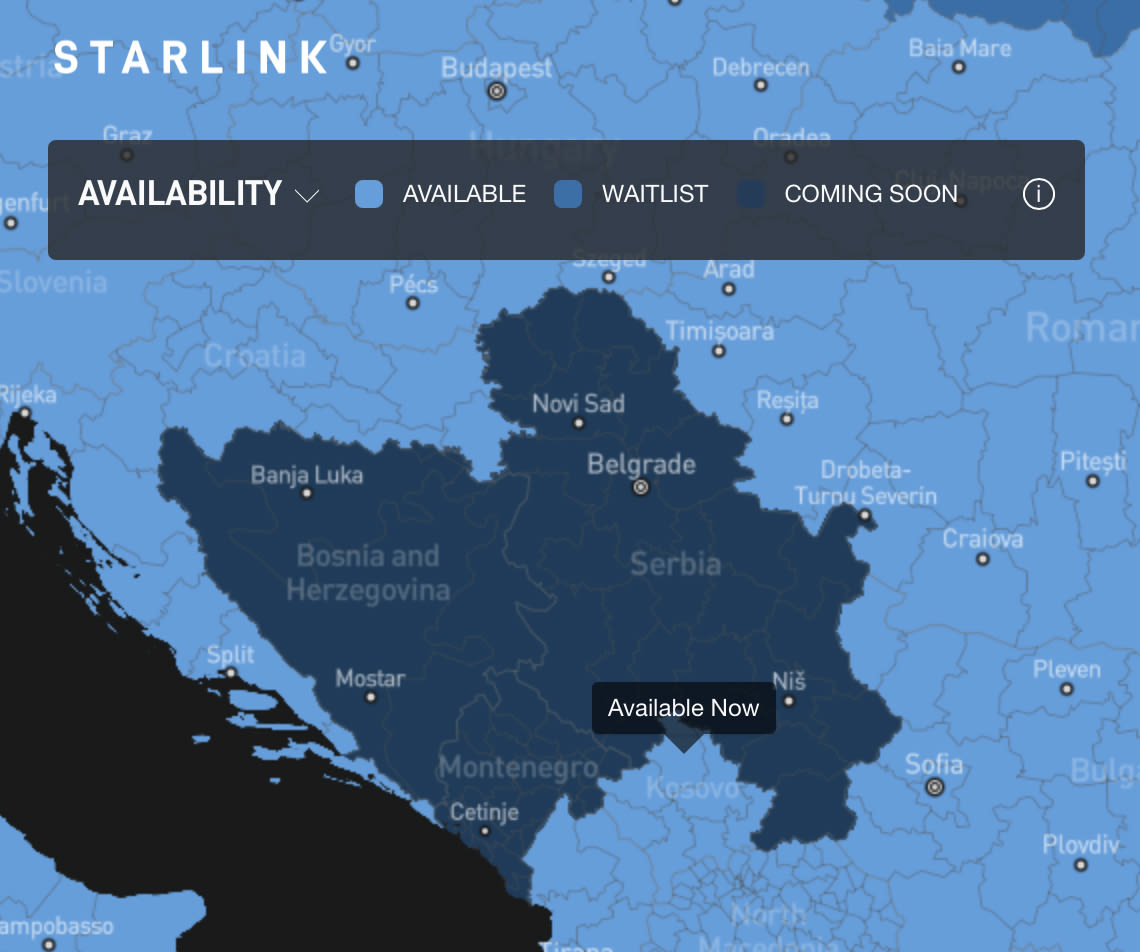
Nauru
First appeared November 6, 2024
Back in March, I wrote about the emergence of Starlink’s new Community Gateways — a new configuration of Starlink that allows the service to act as a transit provider to local internet service providers, typically in remote locations.
In December 2024, the Central Pacific island nation of Nauru unveiled its new Starlink Community Gateway installation. For a cost of $1.25 million (and a monthly recurring fee of $75,000 per Gbps), this new service is expected to begin a new era of high-speed internet service for the 12,000 residents of the world’s third-smallest country.
As was first reported in January by the Megaconstellations X account, the activation of the new service in Nauru was reflected in BGP when Nauruan state-owned Cenpac Net (AS55722) became Starlink’s first customer AS. The BGP visualization below shows a route originated by AS55722 migrating its transit to Starlink (AS14593) beginning at 02:50 UTC on January 12, 2025.
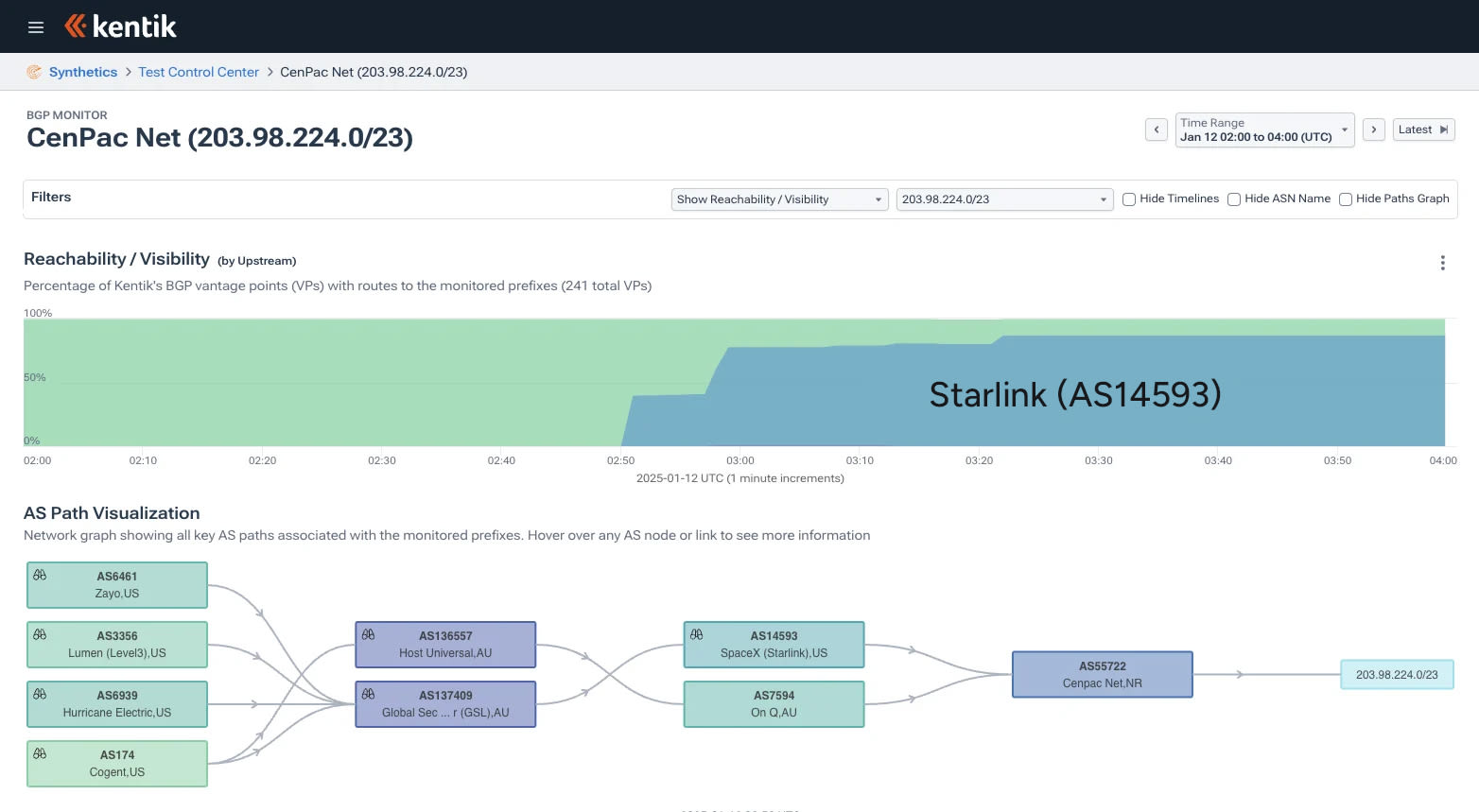
The following GeoIP entries for Nauru appeared in November 2024, weeks ahead of the activation:
116.91.214.0/27,NR,NR-14,Yaren,
116.91.214.128/26,NR,NR-14,Yaren,
116.91.214.192/27,NR,NR-14,Yaren,
116.91.214.224/27,NR,NR-14,Yaren,
116.91.214.32/27,NR,NR-14,Yaren,
116.91.214.64/26,NR,NR-14,Yaren,
2406:2d40:4c80::/42,NR,NR-14,Yaren,
2406:2d40:75c0::/42,NR,NR-14,Yaren,Venezuela, Myanmar, and Sudan
First seen April 2025
The countries of Venezuela, Myanmar, and Sudan each appeared intheStarlink GeoIP file around the same time in April 2025. Venezuela first appeared on April 14, and Myanmar and Sudan at the same time on April 18. A curious development, as the latter countries are locked in protracted civil wars and all three are subject to varying degrees of civil unrest. According to its availability map, Starlink isn’t yet available in any of these countries.
143.105.146.0/24,VE,VE-A,Caracas,
143.105.147.0/24,VE,VE-A,Caracas,
2803:9810:5600::/40,VE,VE-A,Caracas,
129.224.202.0/24,MM,MM-06,Yangon,
129.224.203.0/24,MM,MM-06,Yangon,
135.129.126.0/25,MM,MM-06,Yangon,
135.129.126.128/25,MM,MM-06,Yangon,
143.105.55.0/25,MM,MM-06,Yangon,
143.105.55.128/25,MM,MM-06,Yangon,
2406:2d40:8180::/41,MM,MM-06,Yangon,
2406:2d40:3540::/42,MM,MM-06,Yangon,
98.97.77.0/25,SD,SD-KH,Khartoum,
98.97.77.128/25,SD,SD-KH,Khartoum,
98.97.158.0/25,SD,SD-KH,Khartoum,
98.97.158.128/25,SD,SD-KH,Khartoum,
98.97.183.0/25,SD,SD-KH,Khartoum,
98.97.183.128/25,SD,SD-KH,Khartoum,
98.97.191.0/25,SD,SD-KH,Khartoum,
98.97.191.128/25,SD,SD-KH,Khartoum,
143.105.75.0/25,SD,SD-KH,Khartoum,
143.105.75.128/25,SD,SD-KH,Khartoum,
2a0d:3341:e000::/40,SD,SD-KH,Khartoum,
2a0d:3344:1300::/40,SD,SD-KH,Khartoum,
2c0f:2a80:3000::/40,SD,SD-KH,KhartoumAdditionally, the IPv4 address space assigned to Sudan was previously assigned to Togo. The IPv4 address space assigned to Myanmar was previously assigned to Tanzania. There are presently no IPv4 entries for either Togo or Tanzania.
Conclusion
The Starlink GeoIP file, a seemingly simple CSV document, offers a fascinating lens into the global expansion and operational shifts of SpaceX’s satellite internet service. Our three years of diligently collecting and analyzing these snapshots have revealed a dynamic narrative, from the critical role Starlink played in Ukraine’s internet resilience to its cautious, yet persistent, expansion into politically sensitive regions, like the Palestinian Territories, Kosovo, Myanmar, and Sudan. The ephemeral appearance of “Mars” and the strategic establishment of “Community Gateways” further underscore Starlink’s ambitious vision and its evolving service model.
The growth in both IPv4 and IPv6 entries, coupled with the changing prefix sizes, clearly indicates Starlink’s increasing network sophistication and its efforts to accommodate a rapidly expanding user base across diverse geographical locations. The distinct daily patterns of file updates also suggest a centralized and orchestrated approach to network management.
This initial exploration has highlighted several key events and trends embedded within the GeoIP data. However, the true depth of its story lies in a more comprehensive, ongoing analysis. As we continue to track these changes, future installments of this series will delve deeper into specific regional developments, geopolitical implications, and the technical evolution of Starlink, offering a richer understanding of this groundbreaking internet modality and its impact on global connectivity.
